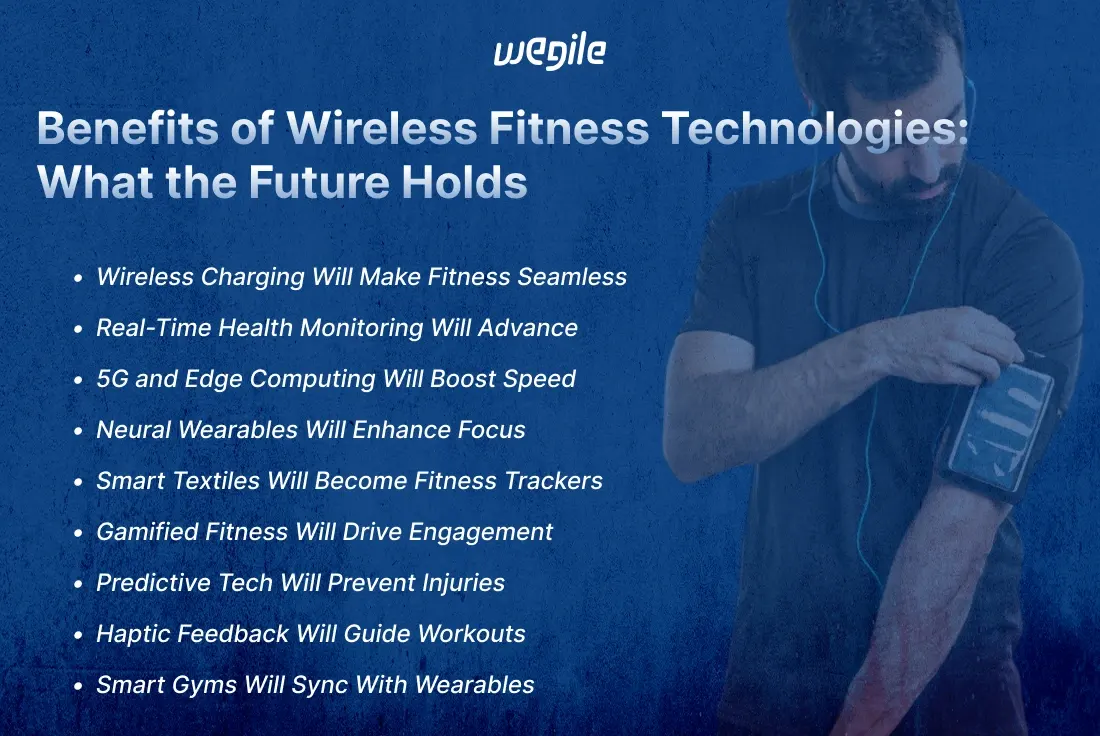Once, Tim Cook shared a personal story about how wearable technology became a lifesaver for his father. His father, who lived alone, suffered a sudden fall at home. The Apple Watch detected the impact and immediately alerted emergency services. When responders arrived, he didn’t answer the door, so they forced their way in, just in time. He had lost consciousness, and without the alert, help might not have reached him in time. This showed that wireless fitness technology is not just about tracking workouts but also about protecting lives in real emergencies."
Well, technology never stands still, and fitness devices prove that every single day. People want gadgets that track workouts without getting in the way, and wireless fitness technologies make that possible. Wires slow people down, so brands push innovation to create seamless experiences that blend health tracking with convenience. The future brings smarter wearables, better connectivity, and real-time health monitoring that changes how people train.
Let’s learn more about the glorious impact and future of wireless fitness technologies:

Fitness tracking started with basic step counters that often miscounted steps and provided little useful data. Early devices lacked precision, making tracking unreliable. First-generation heart rate monitors required chest straps for accuracy, which made them inconvenient for casual users. Calorie tracking was another weak point because early devices estimated calorie burn solely based on step count, often leading to misleading results.
Smartwatches initially focused more on notifications, with health tracking being an afterthought. The real breakthrough came with Bluetooth and Wi-Fi, which allowed faster data sharing and improved tracking capabilities. AI integration then transformed fitness technology by enabling devices to analyze sleep patterns, stress levels, and hydration status.
Despite these advancements, accuracy remains a challenge, and battery life continues to frustrate users. The future of wireless fitness technology will push even further, with new sensors capable of detecting muscle strain and analyzing micro-movements to identify fatigue levels, making workouts safer and more effective.
Artificial intelligence no longer just collects data but also interprets it to offer personalized feedback. Future devices will analyze movement in real-time, preventing injuries before they happen. Smart coaching will become more advanced, offering tailored workout plans that adjust dynamically. AI-driven fitness tech will go beyond tracking to become a personal trainer that learns and adapts.
Devices will detect poor posture and muscle fatigue, warning users before injuries occur.
AI will modify intensity, reps, and form corrections based on real-time performance.
Wearables will provide audible tips on breathing, posture, and pace.
Based on sweat composition and activity levels, devices will recommend hydration and meal timing.
AI will analyze brainwave activity to optimize rest days and avoid overtraining.
Charging remains a major inconvenience for fitness tech users. Smart wearables will soon feature wireless and kinetic charging, eliminating cables completely. Future fitness devices will generate power from movement, light, and body heat, ensuring uninterrupted tracking.
Fitness trackers will convert kinetic energy from movement into battery life.
Body temperature will provide power for small fitness sensors.
These will charge in seconds instead of hours, reducing downtime.
Bands will have solar strips, absorbing light throughout the day.
Gyms and fitness centers will offer wireless charging spots for wearables.
Health tracking devices already measure heart rate and calories burned, but the future will focus on detecting underlying health risks. Wearables will monitor hydration, cardiovascular strain, and even metabolic health, providing immediate insights that help optimize performance.
Devices will analyze how efficiently muscles use oxygen during workouts.
Sweat analysis sensors will detect electrolyte loss in real time.
AI will detect irregular heart activity and recommend medical attention when needed.
Athletes will receive data on muscle endurance without blood tests.
Wearables will suggest rest periods based on micro-tears in muscle tissue.
AI is transforming how telecom operators interact with their customers by offering tailored experiences that boost satisfaction and foster loyalty. With AI, interactions become more personal, relevant, and effective, leading to happier customers and stronger relationships.
Fitness devices rely on fast data transfers for real-time tracking, but slow networks create lag. The future will see wearables powered by 5G and edge computing, enabling instant feedback without cloud processing delays. Devices will handle more data locally, reducing battery consumption and improving response time.
Real-time coaching will be instant, allowing users to adjust their movements immediately.
Fitness apps will sync workout stats instantly across multiple devices.
Devices will process complex analytics on the go.
Faster data transfer will reduce unnecessary battery drainage.
Wearables will verify identity based on movement patterns, reducing security risks.
Mental performance is just as important as physical endurance in fitness. Neural wearables will bring brainwave tracking into fitness training, enhancing focus and improving the mind-muscle connection. Future fitness technology will measure cognitive load, stress levels, and concentration, ensuring workouts are not only physically effective but also mentally optimized.
Devices will monitor attention levels and suggest exercises that improve mental clarity.
AI will analyze neural signals to improve muscle activation, leading to better strength gains.
Wearables will track mental exhaustion and suggest rest periods to avoid burnout.
Neural sensors will measure reflex speed, helping athletes improve coordination and performance.
Future wearables will detect stress and anxiety, adjusting workout intensity accordingly.
Wearable technology will soon move beyond wristbands and smartwatches. Smart textiles embedded with microscopic sensors will track performance, muscle engagement, and even posture without needing additional devices. These fabrics will provide continuous data without disrupting movement, making fitness tracking completely seamless. Instead of checking screens, users will receive insights directly from their clothing through real-time feedback mechanisms.
Shirts and leggings will measure heart rate and blood flow, eliminating the need for chest straps.
Clothing will detect improper form and provide real-time feedback via gentle vibrations.
Smart fabrics will adjust ventilation and insulation based on body heat and sweat levels.
Athletes will see which muscles are working hardest, helping refine technique and prevent injuries.
Shoes and compression wear will alert users when muscle strain reaches dangerous levels.
The future of fitness will not just be about tracking, it will be about engagement. Gamification will bring interactive, competitive elements into workouts, keeping users motivated. Virtual rewards, AI-driven competition, and immersive fitness challenges will make exercise feel less like a chore and more like an exciting experience. Augmented reality (AR) and real-time leaderboards will turn solo workouts into dynamic social competitions.
Users will compete against virtual athletes that adapt to their skill level, pushing them to improve.
AR overlays will create interactive challenges that transform workouts into adventures.
Smart wearables will unlock new challenges based on workout consistency.
Friends and athletes worldwide will compete in real-time fitness challenges through synced devices.
AI-driven feedback will adjust training based on previous achievements, rewarding progress with dynamic difficulty levels.
Fitness technology will move beyond tracking past performance and begin predicting potential injuries before they occur. Advanced AI models will analyze biomechanics, joint stress, and fatigue levels to warn users when they are at risk of strains, sprains, or overuse injuries. Wearables will become proactive tools that help prevent downtime by adjusting workouts before pain or discomfort escalates into serious problems.
Wearables will detect when knee, ankle, or shoulder joints are under excessive strain.
Devices will recognize poor form and alert users before repetitive stress causes damage.
Smart sensors will analyze muscle fibers and suggest recovery before small tears develop into injuries.
Personalized cooldown exercises and stretching routines will adjust based on detected muscle fatigue.
AI will assign injury risk levels based on exercise habits, fatigue levels, and workout intensity.
Real-time coaching is currently limited to audio and visual feedback, but haptic technology will change that by providing physical cues during workouts. Wearable devices will use vibrations, pressure, and resistance to correct form, adjust movement patterns, and guide users without requiring them to look at a screen. This innovation will make workouts more immersive and intuitive, especially for strength training and rehabilitation.
Smart wearables will vibrate or apply slight pressure to correct poor form during weightlifting or yoga.
Devices will guide athletes by providing haptic navigation cues instead of visual maps.
Wearables will adjust resistance bands dynamically, simulating different levels of difficulty in real time.
Smart clothing will provide feedback by tightening or loosening to indicate correct or incorrect movements.
Haptic feedback will improve core stability training by alerting users when their balance shifts incorrectly.
Home workouts are growing, but gym equipment and wearables do not always communicate properly. Future fitness tech will integrate smart home gyms with biometric sensors, allowing machines to adjust automatically based on the user's fatigue and strength levels. AI-driven workout environments will create fully personalized training sessions.
Smart machines will modify weight resistance automatically.
Reflective screens will analyze body movement and suggest corrections.
Virtual environments will adapt workouts based on real-time biometric feedback.
Machines will recognize users and adjust settings to their preferred resistance levels.
Devices will suggest breathing patterns for better endurance during workouts.
Fitness data is valuable, but security concerns grow as devices collect more personal health information. Future fitness tech must prioritize data protection to prevent breaches. Blockchain storage and AI-powered security systems will enhance user privacy, reducing the risk of sensitive information falling into the wrong hands.
Users will control who accesses their fitness data.
Wearables will transmit data securely to prevent hacking.
Only authorized users will access stored health metrics.
Unusual data access attempts will trigger automatic security alerts.
Devices will verify every connection before sharing data.
Wireless fitness technologies evolve every day, creating smarter, faster, and more personalized health tracking. Future wearables will predict injuries, charge through movement, and connect seamlessly with home gym equipment. AI and 5G will enhance real-time monitoring, making workouts more efficient and customized. Fitness brands must balance innovation with security, ensuring users get cutting-edge technology without sacrificing privacy. The future of fitness is wireless, and the next generation of devices will redefine how people train and track progress.
At Wegile, we don’t just build fitness apps, in fact, we engineer smart, connected solutions that enhance user experience and drive results. As the top wearable app development company, we specialize in creating next-generation fitness applications that integrate AI-powered tracking, biometric insights, and seamless connectivity across devices. Whether you’re looking to develop a fitness-tracking app, a smart gym integration, or an AI-powered coaching system, our team has the expertise to bring your vision to life.
Turn your fitness tech ideas into reality with Wegile. Get in touch today and build the future of wearable fitness technology!
Not completely, but features that rely on syncing might pause. Steps and heart rate tracking still work, but real-time stats might not update until the connection comes back. Some devices save data and upload it later, but losing connection during a workout means no live tracking.
Yes, because new sensors will track breathing patterns and skin temperature along with heart rate. Current stress tracking mostly guesses based on heart rate, but future devices will check multiple signals to give more accurate results. Smart bands might even adjust workouts automatically if stress levels stay high.
Fitness tech will shrink because bulky devices annoy people during workouts. Smart rings will track heart rate and movement without needing a screen. Skin patches with sensors will replace big wearables, making tracking invisible. Future fitness tech blends into daily life without needing a wristband or watch.


 Browse Our Services
Browse Our Services
